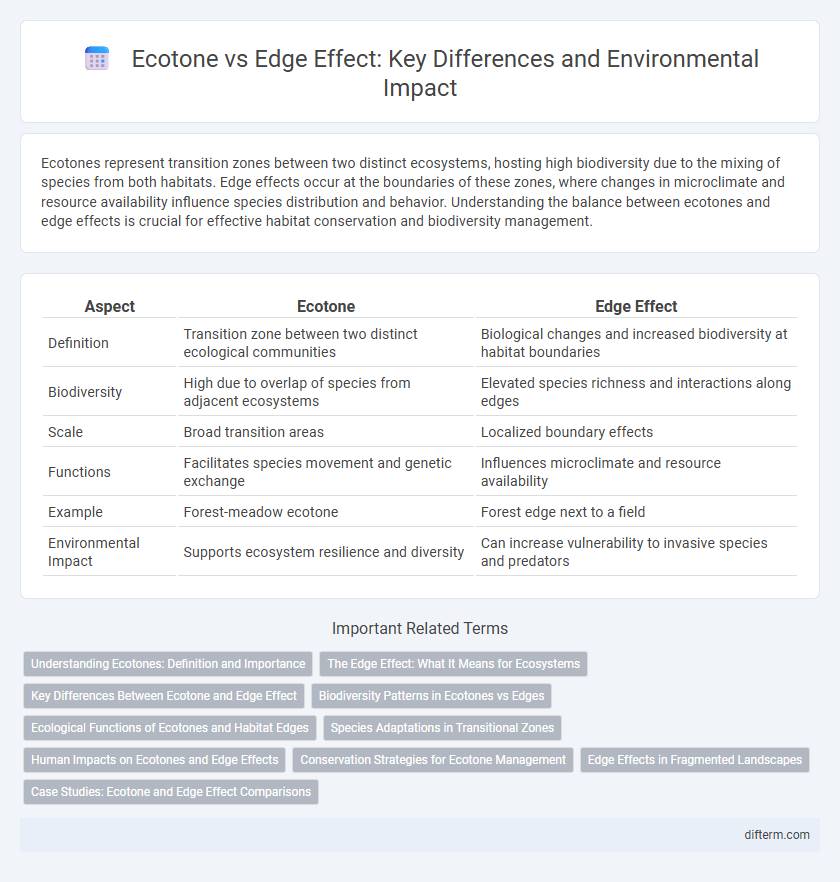Ecotones represent transition zones between two distinct ecosystems, hosting high biodiversity due to the mixing of species from both habitats. Edge effects occur at the boundaries of these zones, where changes in microclimate and resource availability influence species distribution and behavior. Understanding the balance between ecotones and edge effects is crucial for effective habitat conservation and biodiversity management.
Table of Comparison
| Aspect | Ecotone | Edge Effect |
|---|---|---|
| Definition | Transition zone between two distinct ecological communities | Biological changes and increased biodiversity at habitat boundaries |
| Biodiversity | High due to overlap of species from adjacent ecosystems | Elevated species richness and interactions along edges |
| Scale | Broad transition areas | Localized boundary effects |
| Functions | Facilitates species movement and genetic exchange | Influences microclimate and resource availability |
| Example | Forest-meadow ecotone | Forest edge next to a field |
| Environmental Impact | Supports ecosystem resilience and diversity | Can increase vulnerability to invasive species and predators |
Understanding Ecotones: Definition and Importance
Ecotones are transitional zones between two distinct ecological communities, characterized by unique environmental conditions and high biodiversity due to the overlap of species from adjacent ecosystems. These areas often exhibit increased productivity, species richness, and genetic diversity, playing a critical role in ecological resilience and adaptation. Understanding ecotones is essential for conservation efforts, as they serve as indicators of environmental change and hotspots for species interactions.
The Edge Effect: What It Means for Ecosystems
The edge effect refers to the changes in population or community structures that occur at the boundary of two or more habitats, often resulting in increased biodiversity and species interactions compared to interior environments. Edges create unique microclimates and resource availability, influencing ecological processes such as predation, competition, and species dispersal. However, excessive edge environments caused by habitat fragmentation can disrupt ecosystems by favoring edge-adapted species and reducing interior specialist populations.
Key Differences Between Ecotone and Edge Effect
Ecotones represent transition zones between two distinct ecosystems, characterized by unique species compositions and higher biodiversity than adjacent areas. Edge effects refer to environmental changes and increased species interactions occurring at the boundaries of habitats, often leading to altered microclimates and species distributions. Unlike edge effects that emphasize impacts at habitat margins, ecotones highlight the ecological blending and increased biological richness where ecosystems converge.
Biodiversity Patterns in Ecotones vs Edges
Biodiversity patterns in ecotones exhibit greater species richness and ecological complexity compared to edge effects, as ecotones represent transitional zones where distinct ecosystems merge and create unique habitats. In contrast, edge effects often result in altered microclimates and increased vulnerability to invasive species, reducing native biodiversity. Studies show ecotones support specialized species and higher genetic diversity, promoting ecosystem resilience.
Ecological Functions of Ecotones and Habitat Edges
Ecotones serve as critical zones of increased biological diversity and ecological interactions, often supporting higher species richness and unique community assemblages compared to adjacent habitats. Habitat edges, while similarly influential, can trigger edge effects such as microclimatic changes and altered species behavior that sometimes lead to decreased biodiversity or increased vulnerability to invasive species. The ecological functions of ecotones include enhancing nutrient cycling, facilitating species dispersal, and acting as buffers that mitigate environmental stress, whereas habitat edges primarily influence population dynamics and resource availability within fragmented landscapes.
Species Adaptations in Transitional Zones
Species in ecotones exhibit specialized adaptations to fluctuating environmental conditions, enhancing their survival in transitional zones where two ecosystems converge. Edge effects create unique microhabitats that promote diverse species interactions and resource availability, driving evolutionary adaptations such as morphological changes and behavioral flexibility. These adaptive traits enable organisms to exploit niche opportunities in ecotones, contributing to increased biodiversity and ecosystem resilience.
Human Impacts on Ecotones and Edge Effects
Human activities such as urbanization, agriculture, and deforestation significantly intensify edge effects by fragmenting habitats and altering ecotones, leading to increased exposure to invasive species and microclimatic changes. These disruptions reduce biodiversity and compromise ecosystem services by modifying species composition and resource availability within transitional zones. Effective conservation strategies must address the mitigation of human-induced stressors to preserve the ecological integrity and functionality of ecotones.
Conservation Strategies for Ecotone Management
Ecotone management in conservation strategies prioritizes preserving transitional zones between ecosystems to enhance biodiversity and ecosystem resilience. Maintaining these areas helps buffer against habitat fragmentation and supports species adaptation to environmental changes. Targeted restoration efforts in ecotones promote ecological connectivity, crucial for sustaining wildlife corridors and nutrient flows.
Edge Effects in Fragmented Landscapes
Edge effects in fragmented landscapes dramatically alter microclimates, species composition, and ecological processes at habitat boundaries. These changes often increase sunlight, wind exposure, and temperature fluctuations, impacting flora and fauna differently than interior habitats. Consequently, edge habitats may support invasive species and predators, intensifying biodiversity loss and ecosystem instability.
Case Studies: Ecotone and Edge Effect Comparisons
Case studies comparing ecotone and edge effects demonstrate distinct biodiversity patterns, with ecotones often supporting higher species richness and ecological interactions due to gradual habitat transitions. Edge effects, characterized by abrupt changes, can lead to increased species invasions and altered microclimates, impacting native flora and fauna differently. Research in forest-agriculture interfaces and wetland-upland boundaries reveals that management practices tailored to these transitional zones significantly influence ecosystem resilience and conservation outcomes.
ecotone vs edge effect Infographic

 difterm.com
difterm.com